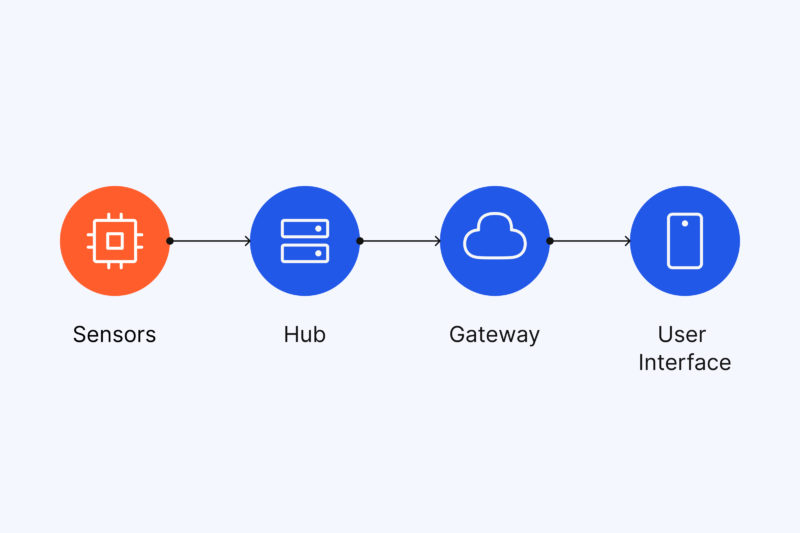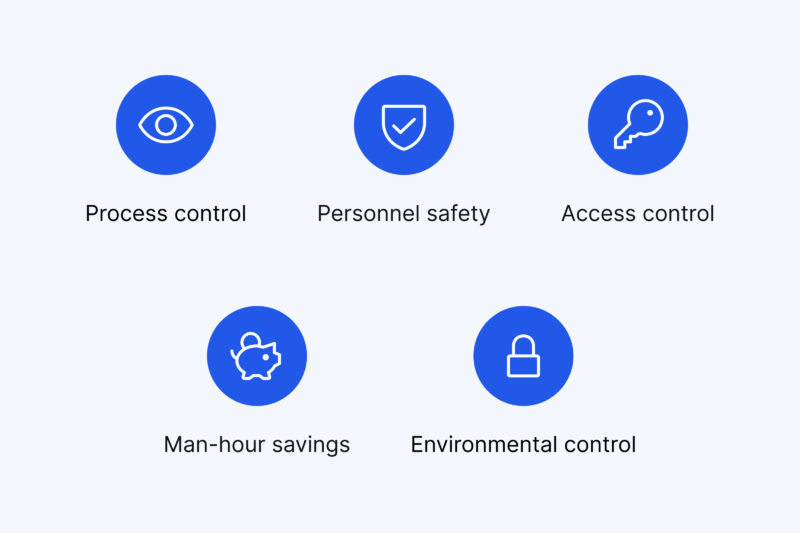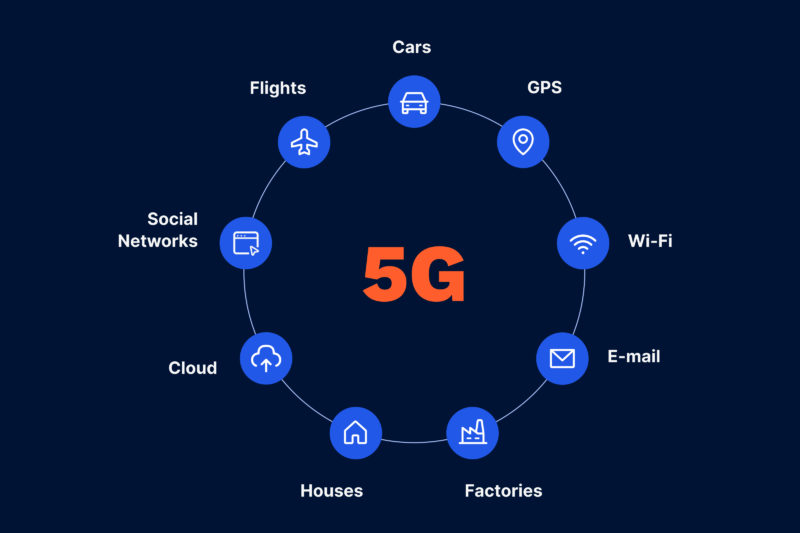
Contact us
Our team would love to hear from you.

We live in a high-speed world. The distance between an idea and its realization is not centuries or decades anymore, but only a few years or even months.
New technologies are turning the world upside down, and experts call these changes the Fourth Industrial Revolution or Industry 4.0. This event associated with the massive integration of cyber-physical systems is supposed to change both our lives and business. One of the technological pillars Industry 4.0 relies on is IoT. In this article, we will find out what IoT in smart manufacturing is and what benefits and challenges it brings to the industrial field.
The Internet of things, or IoT, is the concept of things that interact with each other via the Internet without constant human intervention. IoT encompasses devices with embedded sensors and software for collecting and exchanging data with people and/or other connected devices. To some extent, IoT refers to almost every concept or thing with the prefix smart: smart home, smart watches, smart city, etc.
Before discussing the reasons why more and more industrial companies are accelerating their digital transformation, let’s explore how IoT works. First, we should point out that IoT includes several basic components: devices, connecting networks, IoT platforms (or IoT hubs), and also end users or systems.
Simply put, the process is the following:

IoT smart manufacturing work examples
Talking about the Internet of Things and its processes, we need to pay particular attention to a key tool for developing IoT applications and services that connects physical objects (things) and the network (the Internet) — the IoT platform. It is IoT system software for connecting end devices to the ecosystem and accessing them remotely. This platform acts as a sort of place where IoT components can interact with each other.
Modern IoT platforms perform a wide range of tasks enabling:
Nowadays, there are many off-the-shelf platforms on the market, but the most robust IoT solutions for manufacturing, according to Gartner, are Microsoft Azure IoT, ThingWorx by PTC, and AWS IoT Core by Amazon.
In recent years, IoT has found widespread use in industry as a way to solve a multitude of tasks. IoT used for industrial purposes is commonly referred to as the Industrial Internet of Things (IIoT). IIoT systems are being enthusiastically adopted by many manufacturers because such implementation contributes to improving industrial efficiency and building innovative business models. Thus, in the U.S., about 35% of manufacturers already collect and use data from smart sensors to improve production processes while about 34% of U.S. manufacturers believe the adoption of the Internet of Things in manufacturing is essential. Studies predict that the IoT in the manufacturing market will grow at a rate of 14.76% over the next 5 years.
IoT can be implemented in many production processes that are automatable, especially when there is a need for the remote monitoring of the state of objects and collecting data for future analysis. However, it’s no use introducing technology just to introduce it. There must be value. To figure out what the value is and how IoT can help your enterprise, it is necessary to delve into the specifics of your business. Nevertheless, we will describe the most common cases below.

Benefits of IoT in manufacturing
With IoT, manufacturers can get an overview of manufacturing processes and the state of the product at all stages, from the delivery of raw materials to the shipment of the final product.
Computer Vision systems and sensors keep an eye on whether installation is operated in accordance with standards: thermometers monitor the temperature to avoid overheating, vibration sensors ensure that the amount and frequency of vibration in the equipment is within normal limits, and so on. The systems can also send signals to the control panel to notify personnel if machinery is malfunctioning.
There is more to come. Smart devices collect data from equipment and transmit it to the cloud for detailed analysis, providing information on machine usage parameters: setup times, downtime, minor shutdowns, and more. Therefore, the staff can keep track of performance parameters and predict potential problems.
The process control helps promptly discover a defect in a machine and make a decision to switch to a back-up system. Such a measure prevents the main equipment from reaching the point where it completely breaks down, saves repair costs, and prevents production stops.
The safety of employees and systems is one of the main prerogatives of any industrial organization, so it is imperative to create the most secure environment possible. That is why companies take measures to restrict unauthorized access to strategically important production objects and to limit the access of people to hazardous areas. To ensure the security of the enterprise territory, personnel and assets, it is essential to consider all entry points and potential threats. In order to solve this issue, new technologies are being introduced.
Although digital locks, RFID card readers and security cameras have been around for years, the IoT technology has taken access control and data-driven security to a new level. The fusion of IoT devices with low power consumption, the cloud and advanced security technology has led to the creation of sophisticated, comprehensive and fault-tolerant access control systems.
A sophisticated access control system includes a variety of devices (sensors, smart electric locks, biometric readers, and smart security cameras) that help monitor the presence and movement of people throughout the area. With these IoT-enabled devices, it is possible to monitor the entire security system and remotely track who and when enters the territory.
Smart devices integrated in the factory help keep track of workers’ compliance with the safety regulations. No matter how responsible and disciplined employees are, they are still people who might break rules, intentionally or not. For instance, they may forget to wear a helmet or a respirator. Smart systems practically exclude such a scenario. Smart cameras and smart bands that read movements assist in controlling whether a worker in the shop is in full gear. Special medical examination systems, in turn, reduce the chances of a person with a fever, high/low blood pressure, or intoxication being at work.
IoT in manufacturing has enormous potential in the green economy. The Internet of Things can facilitate sustainable initiatives such as environmental monitoring and energy optimization. Smart sensors can detect excess heat, air pollution, radiation or noise and send alerts, so that the staff can get the situation under control. Moreover, some IoT-enabled devices are programmed to automatically normalize the parameters.
Automatic energy control through a smart grid can improve utility operation and performance. So, the resources are distributed more accurately, and the real needs are addressed without energy waste. Furthermore, in case of emergency IoT devices can level usage between critical and non-critical infrastructure.
Many tasks, such as checking the temperature of pipes, can be done with sensors, saving thousands of man-hours. Meanwhile, the staff can work on more urgent issues. In this way, you can save on the quantity of personnel, reducing the production costs.
To sum up, IoT in manufacturing allows businesses to:
All this can save you millions or even billions of dollars. Yes, transforming your enterprise could be expensive. The initial cost of the digital optimization may become one of the most challenging factors, but imagine how much you’ll save in the future. Ninety percent of manufacturers strongly believe that digitizing their production processes will bring more long-term benefits than risks.
Practically, every business is based on three pillars: quality, cost, and time of production /service delivery. If businesses want to retain and increase their financial performance, they need to make a product uniquely, efficiently , and quickly.
Implementing IoT can be of great help in this regard, but such a solution initially requires a reasonable investment, and then you have to wait for a while until the money pays off. But what to do if you don’t have funds right now and you understand that IoT is the best choice for your business? The traditional option is to look for an investor. But there is another one that is gaining momentum — Product as a Service.
Product as a Service is a business model when the product is provided for use via a lease agreement. The trend has not passed over IoT. IoT-enabled Product as a Service transforms the way manufacturers sell goods and services and the way companies consume them.
At first glance, this model may seem a perfect option as it reduces the risk of asset investment and performance risk. The cost of the technologies required to implement the IoT-Enabled Product as a Service business model is going down thus making them more affordable. The use of open-source technologies and access to out-of-the-box solutions to integrate into IT and OT systems considerably reduces development and implementation costs.
In addition, this model eliminates the need for staff to maintain and support assets since IoT-Enabled Product as a Service vendors take over product support and maintenance in exchange for regular payments. This encourages manufacturers to produce more robust, long-lasting, and easy-to-use IoT-enabled products.
However, there is the flip side of the coin. This model is more efficient in the short term, but usually more expensive strategically, while custom implementation on top of an out-of-the-box platform is more efficient in the long term, but requires more investments from the start.
The amount of data generated in the IoT ecosystem is constantly growing. However, not all information is relevant to an enterprise. Therefore, corporate data centers are gradually moving toward operational data processing in which edge-IoT computing can help. As the name implies, it combines IoT and edge computing technologies.
Edge computing brings data processing as close as possible to an IoT device which in turn analyzes the data and delivers instant results. So, the data is analyzed right at the collection point. Thus, this process eliminates latency and conserves bandwidth.
IoT and edge computing are powerful technologies that can save businesses a lot of time and effort. Using IoT and edge computing together can be a great way to achieve different goals within the same infrastructure by rapid data analysis in real time.

IoT Trends in Manufacturing for 2023
5G technologies are real game-changers and offer enormous potential for IoT. A huge quantity of connected devices (the number is growing to 14.4 billion) and a large volume of consumed data require faster technologies such as 5G.
The technology lessens the need for physical networks: all is wireless. With 5G, a data transfer rate increases dramatically. In addition, the high bandwidth of the new network reduces latency and response time. So, 5G enables data transmission in real time, as the seamless exchange of data between machines, systems, robots and people is an integral part of industrial production.
Artificial Intelligence (AI) and IIoT usually complement each other. In this case, we are referring to the Artificial Intelligence of Things (AIoT), i.e. networks of the Internet of Things controlled by artificial intelligence.
While IoT systems can only collect and organize data, AIoT systems can go further. AI plays the role of the “brain” inside IoT devices. It is due to AI that it is possible to process, analyze, and make informed decisions.
Furthermore, AI performs long-term analysis and builds algorithms enabling enterprises to conduct predictive analysis based on multiple possible scenarios. Therefore, businesses can promptly assess and respond to risks and make changes to operational parameters.
Although IoT systems carry significant business value, it is worth mentioning that there are still some issues to be solved by developers.
Connecting everything to the Internet has opened up fabulous opportunities for cybercriminals. Hence, the issue of cyber security in the workplace is gaining urgency. If an enterprise is going to embark on a path towards digital transformation and IoT implementation, the approach to cybersecurity must be changed. Statistically, 43% of businesses do not fully protect their IoT solutions. Meanwhile, an information attack can cause a control action from outside, which can be malicious and destructive.
Another important challenge is how to incorporate all IoT devices into a company’s infrastructure, given different communication protocols. The situation can become even more complicated if you work in an ecosystem of vendors, logistics companies, or other players and need to be compatible with them.
To get around this problem, decision makers should communicate with all stakeholders and stay up-to-date on evolving IoT standards. In addition, always choose commonly used IoT communication protocols as they typically have strong security features and are more likely to interact with your partners’ technologies.
Legacy systems that are in use in manufacturing can also hinder the adoption of new technologies. In a Forrester Consulting survey, 53% of manufacturers with low maturity admitted that their legacy systems were not able to interact with the rest of their assets at all.
The epoch of future technology has already arrived. It’s time to embark on a significant digital transformation to prepare your business for the cybernated, highly automated economy that Industry 4.0 opens up. It’s important to meet the right partner on the path.
At EffectiveSoft, we have dedicated professionals in IoT software development. Our experts will help you determine what IoT software solution is uniquely suited for your business, and our developers will implement this idea. All you need to do is to send us a request.
Our team would love to hear from you.
Fill out the form to receive a consultation and explore how we can assist you and your business.
What happens next?